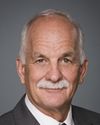You have no qualms about this whole situation. You've just asked us to approve $13 million more for approximately 3% additional requirements under the stimulus package, yet you're able to hold back for the RCMP as well as for the Public Service Alliance. I'm pointing out that this is difficult to do when we're looking at this.
I'd like to ask you a second question, and this goes to our public service health care plan. Do the moneys you're appropriating go at all for the pay direct card? You committed to implementation in 2008; we're nearing the end of 2009. I'm wondering where that is. And is it under your appropriations as well?





